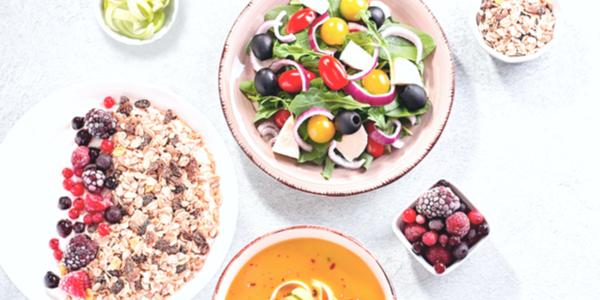
The Volumetrics diet is different from fad diets and was developed by nutrition expert Dr. Barbara Rolls from Penn State University. The focus is on eating foods that are high in volume but lower in calories.
The Volumetrics diet is based on eating real foods with an emphasis on fruits and vegetables. However, as with any diet, it may not be the best for every person.
Our dietitians break down the Volumetrics diet plan based on healthy and effectiveness.
What Is the Volumetrics Diet?
Unlike some fad diets that cut calories and limit portions, the Volumetrics diet is designed to leave you feeling satisfied, not hungry. The Volumetrics eating approach focuses on filling up on foods that are low in calories but high in volume.
The Volumetrics diet divides food into four groups based on their energy density. Ranging from very low energy to high energy density, these foods include:
1. Very low-energy-density foods: non-starchy fruits, vegetables, broth-based soups, and non-fat milk
2. Low energy-density foods: starchy fruits, vegetables, grains/cereal, low-fat meats, legumes, and low-fat mixed dishes like casseroles
3. Medium energy-density foods: meat, cheese, pizza, French fries, bread, ice cream, cake.
4. High energy-density foods: crackers, chips, chocolate, cookies, roasted nuts, butter, and oil.
Category one foods should be eaten freely and often. Category two can be eaten in moderation, and category three should be eaten in small portions. Not surprisingly, category four should be eaten in limited quantities.
This style of eating does not have a rigid list of specific foods to eat at mealtimes but rather is more a philosophy of how to eat. It is designed to help you shift from category three and four foods to more one and two foods.
By doing so, you will not feel hungry or deprived but rather be able to eat a larger volume of food that is also higher in fiber and lower in calories.
Is Volume Eating Healthy?
Health experts agree: the Volumetrics diet is a healthy approach to eating. It is based on eating nutritious, nutrient-dense fruits and vegetables while emphasizing limiting empty calorie foods like fast food, sweets, and processed snacks.
US News & World Report rates diets every year based on a panel of health experts. Volumetrics diet is considered a safe diet for all age groups and was rated a top-five diet in the best diets overall category.
Volumetrics Recipes
The good news is Volumetrics recipes are varied and almost endless as long as they are rooted in mostly category one foods. Volumetrics recipes can be individualized based on which fruits, vegetables, grains, and low-fat dairy you like.
Broth-Based Soups
A mainstay for Volumetrics eating plan is broth-based soups. This is because broth-based soups are mainly water, have a high volume but low energy density. Make sure to have broth-based soups that are filled with vegetables to keep it Volumetrics friendly.
Limit cream-based soups or find ways to cut back on cream and make them lighter. For example, this creamy carrot and sweet potato soup is Volumetrics friendly by being mainly vegetables, broth and has just a small amount of half and half. Creamless cream of cauliflower soup is another example of implementing Volumetrics principles by making it a broth-based soup instead of cream.
Salads
Any leafy green based salad paired with a variety of other vegetables, legumes, grains, lean protein and light salad dressing would be considered a Volumetrics recipe. A lunch-friendly Volumetrics recipe can be mason jar salads.
Colorful, Vegetable-Based Dishes
Any vegetable-based dish can be considered a Volumetrics recipe as long as it fits the other food categories as well (i.e. low in butter, oil, limited meats, etc.).
An example of a dinner entree that is Volumetrics centered is seasonal vegetables with Thai orange sesame sauce. Any dishes that highlight plants, like green foods, can be an easy way to implement Volumetric principles.
Pros and Cons
The Volumetrics diet has many pros, but also some cons. In order to determine if the Volumetrics approach is best for you, consider these pros and cons.
Pro: Flexible Food Options
Unlike some fad or restrictive diets, Volumetrics is flexible for what foods you choose. The premise is on choosing low energy-dense foods, like fruits, vegetables, broth-based soups, but the options for which foods from these groups to pick are up to you. The degree of how closely you follow the 4 suggested food categories is also flexible.
Pro: Weight Management
The Volumetrics approach to eating can help people manage and lose weight. Dr. Rolls and others on her team have several research studies suggesting this approach can be a sustainable approach to weight management.
One study found after 6 months large and modest shifts in lowering energy density with Volumetrics approach were associated with weight loss and overall improved diet quality.
Pro: Not Focused on Macronutrients
Some diets emphasize the need to get X number of calories from carbohydrates, fat, or protein. Some diets emphasize low-carbohydrate foods, while others emphasize low-fat foods.
However, many studies have shown all macronutrient ranges can lead to the same end goal of weight loss at 6 months, 1 year, and 2 years. What Volumetrics focuses on instead of macronutrient composition is reducing total energy density.
Focusing on getting a certain amount of carbohydrate, protein, or fat in the diet can be tedious and sometimes overwhelming. Focusing on eating whole foods, like with Volumetrics, is a more sustainable, balanced approach to health and weight regulation.
Pro: High in Fiber
High fiber intake is associated with a reduced risk of heart disease, high blood pressure, diabetes, and certain gastrointestinal diseases. The Volumetrics diet emphasizes foods high in fiber such as fruits, vegetables, whole grains, and legumes.
Most American adults only get about half of the recommended 25 to 30 grams of fiber per day. Therefore, switching to a Volumetrics eating approach can help you meet and exceed daily fiber recommendations.
Con: Limits Some Healthy Fat Sources
One thing about Volumetrics that may not be beneficial for everyone is the limiting of oils, butter, nuts, and other fat sources. These foods have a high energy density, so they need to be limited within the Volumetrics design.
However, some people may benefit from having a higher intake of these foods, especially heart-healthy options. Athletes, those trying to gain weight, and those with certain medical conditions are some examples who may benefit from a more liberal approach to some higher-calorie foods. Therefore, this is something to keep in mind when considering a Volumetrics approach.
Con: High Amount of Food Prep
Adding in more fruits, vegetables and soups can mean more time prepping food in the kitchen. Some may see this as a potential downside of implementing the Volumetrics approach.
However, this does not have to be the case when eating more fruits and vegetables in the diet. If time and food prep is a concern, simply focus on quick, easy healthy recipes.
The Bottom Line
The Volumetric approach to eating emphasizes a diet high in fruits, vegetables, whole grains, legumes, and low/non-fat dairy. It is considered a healthy way of eating that can help most people eat a healthy, balanced diet without having rigid eating rules or eliminating foods.
Research has suggested lowering the energy density of your diet, like with Volumetrics, long-term weight loss can occur regardless if the diet is low carb, low fat, etc. And overall, following this sort of meal plan can have followers feeling full without eating lots of calories.
References:
Volumetrics Diet. U.S. News & World Report. https://health.usnews.com/best-diet/volumetrics-diet.
Blanton N. Debating Diets: What is the volumetrics diet? Baylor College of Medicine Blog Network. Published January 12, 2021. https://blogs.bcm.edu/2021/01/12/debating-diets-what-is-the-volumetrics-diet/.
Smethers AD, Rolls BJ. Dietary Management of Obesity: Cornerstones of Healthy Eating Patterns. The Medical clinics of North America. Published January 2018. https://www.ncbi.nlm.nih.gov/pmc/articles/PMC5726407/.
UCSF Health. Increasing Fiber Intake. Published October 6, 2020. https://www.ucsfhealth.org/education/increasing-fiber-intake.







